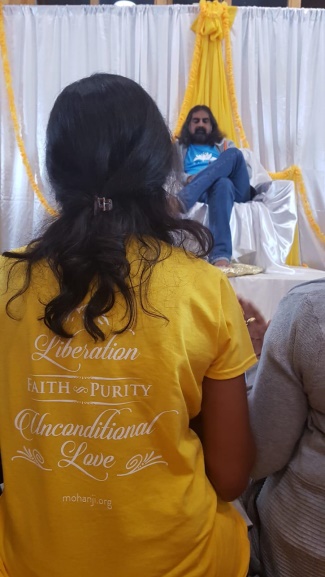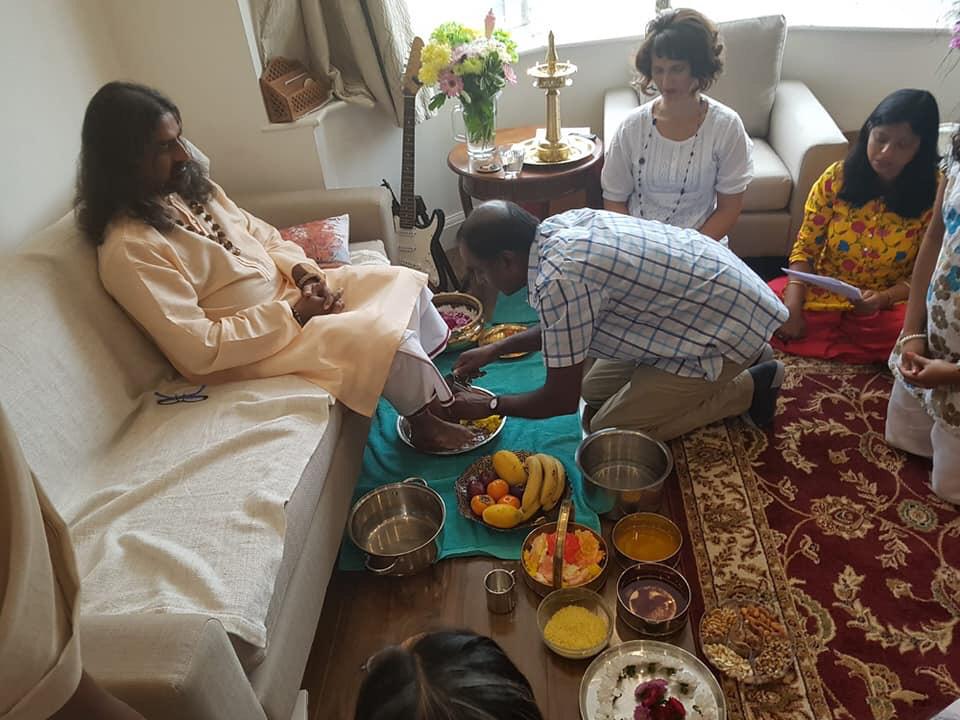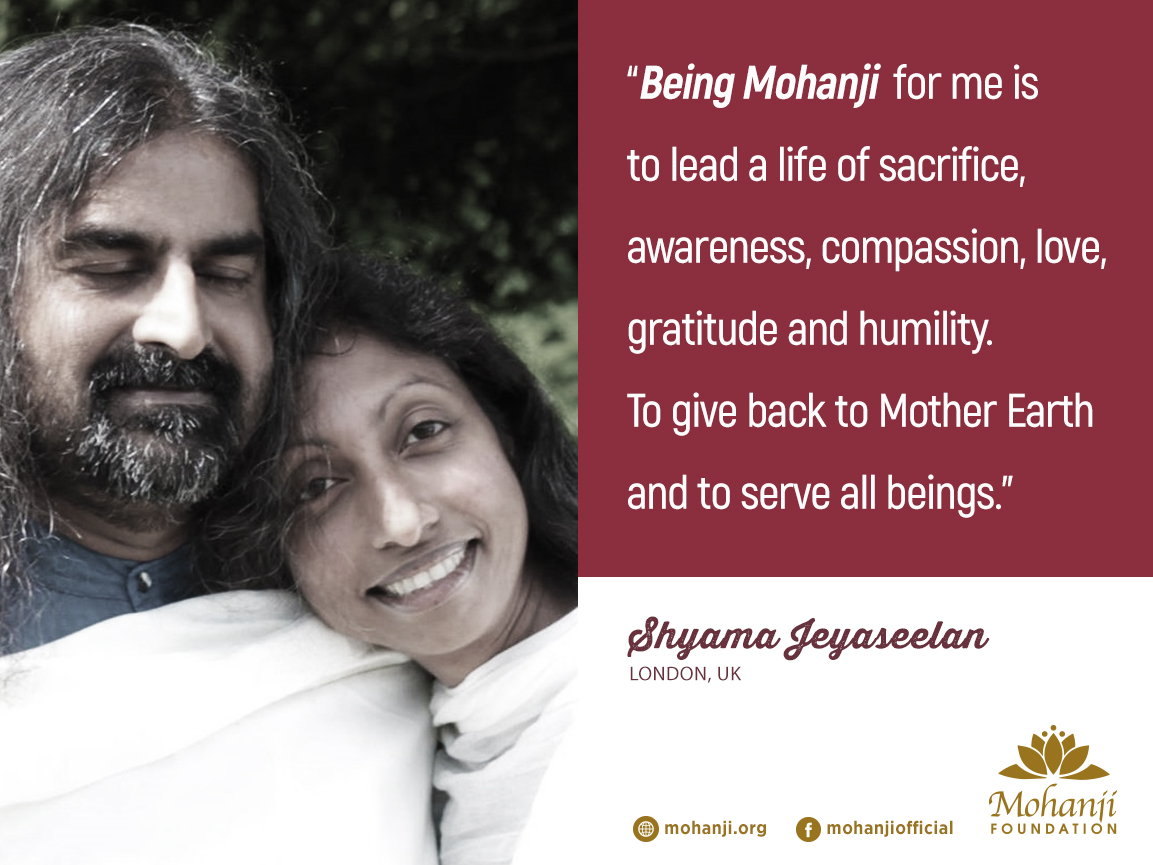By Shyama Jeyaseelan
Mohanji says, “The human mind needs forms to associate with. This is fundamental. It recognizes forms and connects to forms. Human constitution uses all faculties such as body, mind, and intellect to connect to the chosen form. And when the connection through faith increases, individual personality takes a back seat. The individual starts to merge with the object of worship. Non-duality happens. When oneness takes root, often the need for any of the individual faculties that the individual used for the primary connection also becomes redundant. Everything dissolves into oneness.”
In May 2018, towards the end of the Kriya Intensive programme and Volunteers Meet in Bosnia, some of us were sharing our experiences with Mohanji in the main satsang hall. Seated in a circle, heartfelt feelings and emotions were shared, all of us totally absorbed in Mohanji’s love and compassion. When it was my turn, I sang a bhajan that was close to my heart, one that I sing often at home to Mohanji. The words are simple yet so beautiful.
You are the centre of my life my Lord, You are the centre of my day
I open my heart to You and pray for Your grace
I feel the power of Your love my Lord, I feel the power of Your love
I open my heart to You and pray for Your grace.

As I finished, Deviji who was also seated with us said with a lovely smile, “I am looking forward to meeting all the bhakti yogis in London soon.” A visit by Mohanji, Deviji, and little Mila was already planned to take place in August 2018 and we were all counting the days for their arrival with much excitement, looking forward to having them with us.
During their stay in London, many of us had the privilege of spending some time with Mohanji, Deviji, and Mila. So many beautiful moments, full of grace and joy, filled our days. Those few days flew by quickly and it was time to say good bye too soon. Afterwards, as I read the blogs and testimonials from others, I realised how each of us experienced Mohanji’s presence and love in our own unique way. We may have all been with Him at the same time during the same programme or event, but each one of us experienced Him according to our own constitution, perception, and eligibility.
During this visit, every moment I spent with Mohanji gave me a different emotion to the feeling of devotion. I recently read a beautiful article on ‘Nava vidha bhakti,’ the 9 forms of devotion, and realised that I had experienced these beautiful emotions and recognised them as such, purely because of Mohanji’s grace.
It is said that of the different types of yoga, bhakti yoga is the easiest way to reach the Lord in the Kaliyuga. When devotion and love for the Lord are pure, free from conditions, desires, and ego, transformation happens within. We become the instrument of the Lord. Through writing this article, I pray that my love for Mohanji becomes deeper and purer. May devotion fill my days and bring positive transformations within me.
The 9 forms of devotion which we feel and experience towards our Guru or God are shravanam, kirtanam, smaranam, paada sevanam, archanam, vandanam, daasyam, saakhyam, and aatma nivedanam.
1. Shravanam (Listening to the names and glories of God)
The first in the nine forms of devotion, shravanam is to listen to the divine glories of our Guru or God. As we listen and contemplate on His words, qualities, and divine plays, our mind merges with the thoughts of divinity. With easy access to social media, listening to satsangs, bhajans, and songs, seeing messages on whatsapp or Facebook were all tools for me to listen or read about Mohanji throughout the day. Listening to His teachings, seeing His messages and reading others’ experiences were all ways for me to connect to Him while being away from His physical presence. Planning His visit with the UK team was exciting and that itself was a satsang too. As I constantly listened and contemplated on Mohanji, love and reverence subconsciously grew and I also realised that these thoughts were purifying me in tangible and subtle ways.
As we cultivate a yearning to listen to His glory and teachings with faith, and as we practise what we have learnt, the act of shravanam helps us evolve in the journey of spirituality.
2. Kirtanam (Chanting the glories of God)
In the second form of devotion, kirtanam, one sings the glory of Guru or God with devotion. Whenever we recite or chant His name and sing His glory from the heart, we automatically become joyous; our hearts are filled with love, not just for our dearest Guru, but towards all those who are around us. Continuous chanting has the power to elevate us.
At the UK retreat, we had bhajans at the end of each day. Even if He was tired, Mohanji would stay and listen to everyone’s offering of love to Him, have a satsang with us afterwards, before retiring to His room. One of the highlights was to actually listen to Mohanji sing ‘Garuda Gamana’ with one of the devotees. We were all mesmerised, listening to His beautiful voice, giving such joy not only to the devotee He sang with but to all those who were assembled there.

One evening, we chanted the Sri Rudram in Mohanji’s presence. This chanting is done in praise of Lord Shiva and I was reminded of chanting it at the holy banks of Manasarovar and also during the parikrama of Kailash. Lord Shiva who was silent and majestic in Kailash had taken the form of the compassionate and loving Mohanji who was physically in the room with us. Although thousands of miles apart, the innocence, divinity, and purity that I felt was the same in both occasions, and I felt so blessed to have Mohanji there with us while chanting. None of us wanted these evenings to end!
3. Smaranam (Remembering God)
Smaranam is the third form of devotion where one constantly remembers their Guru or God and His divine qualities. It is said that namasmarana, the constant chanting, and remembrance of the divine will help us attain liberation. Remembering and chanting the name of our loving Guru, remembering His compassionate form, seeing divinity in nature are all ways of remembering Mohanji’s presence in my life.

Whether it’s chanting the Mohanji Gayatri, Healing Gayatri or singing devotional songs/bhajans, I feel that simply knowing/remembering that He’s always with me, keeps me connected to Him, making life the joyous journey it is. As faith and devotion increase, surrendering my actions to Him becomes second nature and from small miracles to large, I feel Mohanji’s presence throughout the day. As acceptance and patience increases, pain and suffering are greatly reduced and I am able to face life with equanimity more and more.
4. Paada sevanam (Serving the Lord’s feet)
In the fourth form of devotion, paada sevanam, one worships their Guru or God by surrendering all actions at His feet and serving Him. Recognising that a true Guru is connected to the supreme consciousness, worshiping the paaduka (sanctified sandals) is also a form of paada sevanam.
In the Indian tradition, people often refer to the Guru or God’s feet as paada pankajam (lotus feet), as they are described as soft and beautiful like the petals of a lotus. During this visit, we had the incredible opportunity of doing Paada puja to Mohanji’s feet. It was such a sacred event and all those who took part felt so blessed. Mohanji explained the significance of this sacred ritual and graciously allowed us to wash, decorate and do aarati to His feet. It was a dream come true, something many of us had yearned for but had not expected to happen.

Bowing down at the feet of someone shows humility and lack of ego. As we bow down at the feet of our dearest Guru with an innate sense of surrender, we recognise His divinity and pray that He will grant us protection and lead us from the many bindings of life to freedom in existence.
5. Archanam (Worshipping God)
In the fifth form of devotion, archanam, one makes an ‘offering’ of love to their Guru or God. It may be ritualistic worship where food, flowers, and many other materialistic items are offered. It can also be singing bhajans, chanting the sahasranamam (1000 names), ashtothram (108 names) or doing aarati, which are all forms of archanam. When the rituals are combined with internal meditation and awareness, our hearts and minds are purified.
While Mohanji was in London, I had the opportunity to make some of His meals along with a few other devotees. Cooking is usually not my passion, but making food for Mohanji is a blessing I will always cherish. I can only imagine this would be how Yashoda felt when she made food for Krishna! Mohanji’s enjoyment of simple food is lovely to witness. The times I spent in the kitchen gave me such a close connection to Mohanji. Nothing else existed apart from Him. In those moments I was not a parent, wife, sister or daughter. There was no personality, just an amazing feeling of not existing as a person with ego, etc., but being an empty instrument for divinity to work through. This state of perpetual meditation which seemed beyond my reach seems a little closer to attain now, a state I should attempt to be in, throughout the day.
My archanam or offering while Mohanji was here in the physical form for a few fleeting days has enabled me to surrender and offer all my actions to Him even when He’s physically not present. Expressing our love for Him and connecting to Him with mind and heart, all our actions become sacred when offered at the feet of the Guru.
6. Vandanam (Offering obeisance to God)
The sixth form of devotion is reverential prayer, vandanam, to our Guru or God. Prayer is a language of the heart and when expressed with sincerity and love, it becomes an intensely personal process which elevates us. There are many types of prayers; of gratitude, for the well-being of others, for peace, etc.
Prayers and chanting have become a part of life and I realise Mohanji purifies us in subtle ways when we undertake these actions with the correct intent. Whether it’s chanting, singing or simply talking to Mohanji in my mind and seeing answers to my questions or thoughts through someone or something, my faith in prayers has increased manifold. Whether it’s an internal dialogue or an outward expression, prayers make me feel more close to Mohanji. I share an incident here which showed me again He knows everything that we think, say or do, that we always live in the presence of divinity.
On the last night before Mohanji’s family left, I was feeling so sad. I sent a text message to the host family saying, “Tomorrow morning will be the last meal with Mohanji for a while.” I had not asked to help make breakfast as I knew someone else was bringing food in the morning but went to help with other things. Just a short time before leaving for the airport, Mohanji said, “Let’s have some uppma.” I thought He was joking as He knew someone was bringing breakfast and said, “Mohanji, are you serious?” He replied with a smile “I never joke about food.” As we rushed about in the kitchen with last minute preparations, I realised that Mohanji knew my thoughts and feelings and in His usual compassionate way, asked me to make something to make me happy. Always so caring and loving, He spreads joy in every possible way. That morning we had two different items for breakfast, blessed by Mohanji!
7. Daasyam (Serving God as His servant)
In the seventh form of devotion, daasyam, one aspires to be of personal service to their Guru or God. With no sense of inferiority, one yearns to serve the Guru as well as His devotees. Only those who are trustworthy, truly humble and are not self-centred are given this boon and it’s amazing to see Mohanji’s interaction with such beautiful people. He’s so relaxed and happy in the midst of those who love Him unconditionally and serve Him selflessly.

Hanuman’s devotion to Lord Rama is a great example of daasyam. I have heard Mohanji speak of Hanuman with so much love and share here a story He narrated a couple of years ago. When Valmiki completed the epic Ramayana, Sage Narada who read it said that Hanuman’s Ramayana was better. Valmiki was not happy that a ‘monkey’ had also written a Ramayana and wanted to find out if it was indeed better.
Valmiki found Hanuman in Kadali-vana (plantain grove) and the Ramayana inscribed on the broad plantain leaves. Reading it, he found it to be exquisite and unable to help himself, started to cry. When Hanuman asked if it was that bad, Valmiki replied he was crying because it was so beautiful and no one would read his Ramayana once they read Hanuman’s Ramayana.
Hearing this Hanuman simply tore up the banana leaves and said, no one will read Hanuman’s Ramayana. You wrote it so that the world remembers you, but I wrote it so that I remember Ram.” Hearing this story of Hanuman’s pure love for Lord Rama in Mohanji’s mesmerising voice was simply amazing and it brought tears to my eyes.
Even now, when I think back to this moment, I feel so humbled to be a part of Mohanji’s family, receiving His love and grace, and pray that such intense devotion and purity wells within me too.
8. Saakhyam (Developing friendship with God)
In the eighth form of devotion, saakhyam, the devotee considers the Guru or God as their friend. An example of this is Lord Krishna’s childhood in Vrindavan. He spent the days playing with his friends and taking care of the cows. His friends would chase him while playing, massage his legs while resting and feed him food with love. Their love for Krishna was complete. Mohanji is also our true friend, who accepts us as we are, with no judgements or expectations, interacting with us with pure love.

It is always a joy to see Mohanji relaxing at times, away from His back to back programmes. One evening after Mohanji had retired to His room, a couple of us were talking about a song that Mohanji really likes and we were listening to it on you tube. The next morning while having breakfast, He started talking about the song as if He’d been there during our conversation! Then He asked us to play that song and started to sing along with Sonu Nigam (a famous Indian singer), His deep voice perfectly complementing the singer’s higher pitch. Very sweetly, Mohanji would explain the meaning of the song to me between singing the verses, as I was the only person there who didn’t understand the language. It was a privilege to see Mohanji’s carefree attitude and joyous singing. How blessed we are to have the eternal friendship of our Guru.
9. Aatma nivedanam (Total surrender of oneself to the Lord)
In the ninth form of devotion, aatma nivedanam, the devotee surrenders completely to the will of the Guru or God with no trace of ego. The devotee if completely filled with devotion, gains the knowledge of his true self and becomes one with the divine and all aspects of His creation. When we offer everything to our Guru with equanimity, we become His instruments, and the Guru takes complete care. He knows what is right for us, all we need is trust and full faith.

Mohanji is a living example of simplicity and humility. He teaches us by being a true inspiration. Mohanji encourages us to serve with love and humility, not just those who visit Him or are in His fold, but all beings of the earth, to the best of our capacity. By cultivating love and serving the needy, we realise the existence of divinity in all forms.
Taking up one or a number of these paths to connect with our beloved Guru, understanding the path and following it with faith and consistency, we can make our lives purposeful and meaningful. We become the pure instruments of the Guru, spreading unity, purity, and divinity to the world.
“Worshipping the Guru, considering him as representing the Lord Almighty or personification of the Lord is definitely the path of those who are inclined to Bhakti or devotional path of spirituality.” – Mohanji

|| JAI BRAHMARISHI MOHANJI||
Compiled, Edited & Published by – Testimonials Team, 14th May 2019
*************************************************************************************
Disclaimer:
The views, opinions and positions expressed by the authors and those providing comments on these blogs are theirs alone, and do not necessarily reflect the views, opinions or positions of Mohanji, Mohanji Foundation, it’s members, employees or any other individual or entity associated with Mohanji or Mohanji Foundation. We make no representations as to accuracy, completeness, timeliness, suitability or validity of any information presented by individual authors and/or commenters on our blogs and will not be liable for any errors, omissions, or delays in this information or any losses, injuries or damages arising from its display or use.
We reserve the right to delete, edit, or alter in any manner we see fit blog entries or comments that we, in our sole discretion, deem to be obscene, offensive, defamatory, threatening, in violation of trademark, copyright or other laws, of an express commercial nature, or otherwise unacceptable.
— Mohanji Testimonials Team

1 thought on “Nine ways to connect with the Guru”
Beautifully written and you made me walk through my memories . Thank you